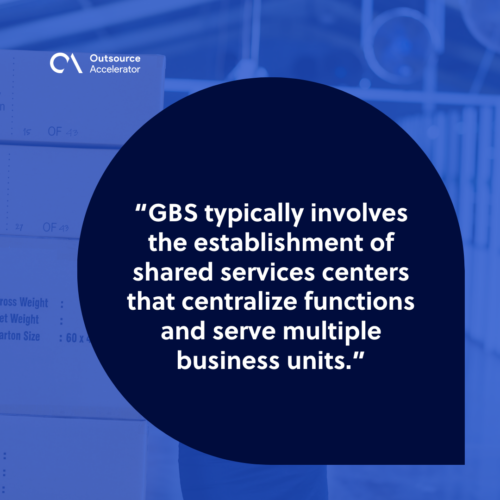Global business services vs. Outsourcing: Which is a better choice?

For modern businesses, two strategies have become pivotal for optimizing operations and driving growth – global business services (GBS) and outsourcing.
These approaches have reshaped how companies manage their resources, streamline processes, and achieve cost efficiencies. Both offer unique pathways to achieving operational excellence, yet they differ in their execution and impact.
In this article, we’ll compare global business services vs outsourcing, examining their key characteristics, advantages, and best practices.
Ultimately, we will guide businesses in determining which approach aligns best with their strategic goals.
Global business services vs. Outsourcing: Definition of terms
Let’s start by defining both terms:
What is global business services?
Global business services (GBS) refer to an integrated approach to delivering business services within an organization.
This model consolidates various support functions, such as finance, human resources, IT, and procurement, into a single, unified structure.
GBS leverages standardized processes, shared technology platforms, and best practices. It aims to enhance efficiency, reduce costs, and improve service quality across the organization.
This approach enables a more strategic and streamlined management of resources. It often operates across multiple geographic locations to provide consistent, high-quality services to internal stakeholders and, in some cases, external customers.

What is outsourcing?
Outsourcing, on the other hand, involves contracting out specific business functions or processes to external service providers.
This strategy is often used to:
- Reduce operational costs
- Access specialized expertise
- Allow the organization to focus on its core competencies
Outsourcing can encompass a wide range of activities, from IT services and customer support to manufacturing and logistics.
The external providers, who may be located domestically or internationally, take over the responsibility for these functions.
While outsourcing can lead to significant cost savings and operational efficiencies, it also requires careful management. This helps firms ensure quality, compliance, and alignment with their strategic goals.
Global business services vs. Outsourcing: Key characteristics
GBS and outsourcing are two distinct strategies organizations employ to manage their business processes more efficiently.
While both approaches may have similarities, they differ in execution and key characteristics.
| Global business services vs. Outsourcing: Key characteristics | |
| Global business services | Outsourcing |
|
|
Key characteristics of global business services
GBS streamlines organizational functions like finance, HR, and IT by consolidating and standardizing processes.
In this section, we will highlight the key characteristics that define GBS:
Integration of services
As mentioned earlier, GBS integrates multiple business support functions, such as finance, HR, IT, and procurement, into a single, unified structure.
This integration fosters a more streamlined and cohesive operation, enabling standardized processes and shared technology platforms.
Internal focus
GBS typically operates within the organization, providing services to internal stakeholders rather than outsourcing these functions to external vendors.
An internal focus allows for greater control over service quality and alignment with organizational goals.
Global reach
GBS often operates on a global scale, leveraging resources and capabilities across various geographic locations. Global presence ensures consistent service delivery and efficiency gains through economies of scale.
Strategic management
The GBS model emphasizes strategic resource management, aligning business services with the organization’s overall strategy.
It involves continuous improvement, innovation, and the adoption of best practices to enhance service delivery.
Shared services centers
GBS typically involves the establishment of shared services centers that centralize functions and serve multiple business units.
These centers are designed to optimize efficiency, reduce redundancy, and provide a unified service experience.
Key characteristics of outsourcing
As for outsourcing, here’s a brief explanation of its distinct characteristics:
External providers
Outsourcing involves contracting out specific business functions or processes to external service providers. These providers can be located onshore, nearshore, or offshore.
Cost efficiency
One of the primary motivations for outsourcing is cost reduction.
Organizations can achieve significant savings on operational expenses by leveraging the economies of scale and lower labor costs offered by external providers.
Focus on core competencies
Outsourcing allows organizations to focus on their core competencies by delegating non-core functions to specialized vendors.
Companies are able to allocate more resources and attention to activities that directly contribute to their competitive advantage.
Flexibility and scalability
Outsourcing offers flexibility and scalability, allowing organizations to adjust their operations quickly in response to changing business needs.
Service contracts can be tailored to accommodate fluctuations in demand, providing a scalable solution.
Risk management
By outsourcing certain functions, organizations can mitigate risks associated with those activities.
Outsourcing providers often have robust risk management practices and compliance measures in place, reducing the burden on the contracting organization.
While GBS focuses on internal integration and strategic management, Outsourcing leverages third-party providers for specialized expertise and cost savings.

Global business services vs. Outsourcing: Best practices
The best practices for implementing these strategies vary based on their unique characteristics and operational models.
Best practices for global business services
For successful GBS operations, growing businesses must take into consideration the following best practices:
Centralized governance
Establish a centralized governance structure to oversee GBS operations. This ensures consistency, compliance, and alignment with the organization’s strategic objectives, facilitating effective decision-making and accountability.
Process standardization
Implement standardized processes across all GBS functions to achieve efficiency and consistency.
Standardization helps in reducing errors, improving quality, and enabling seamless integration across different business units and locations.
Technology integration
Leverage advanced technology platforms to support global business services operations.
Integrated technology solutions enhance data visibility, streamline workflows, and enable real-time analytics, driving better decision-making and operational efficiency.
Performance metrics and KPIs
Define and monitor key performance indicators (KPIs) to measure the effectiveness of GBS services. Regularly reviewing these metrics helps identify areas for improvement and ensures that GBS delivers value to the organization.
Continuous improvement
Foster a culture of continuous improvement within GBS.
Encourage innovation, regularly review processes, and adopt best practices to enhance service quality and operational efficiency over time.
Best practices for outsourcing
To foster positive outcomes when outsourcing, firms must also be aware of these best practices:
Clear contractual agreements
Develop comprehensive and clear contractual agreements with outsourcing providers.
Contracts should outline the following:
- Scope of work
- Performance expectations
- Service levels
- Penalties for non-compliance
These ensure mutual understanding and accountability.
Vendor selection and management
Conduct thorough due diligence when selecting outsourcing vendors. Choose providers with a proven track record, relevant expertise, and cultural compatibility.
Effective vendor management includes regular performance reviews and maintaining open communication.
Risk management
Identify and mitigate risks associated with outsourcing.
This involves assessing potential risks related to data security, regulatory compliance, and service continuity and implementing appropriate safeguards and contingency plans.
Focus on core competencies
Outsource non-core functions to allow the organization to concentrate on its core competencies. This strategic focus enables better resource allocation and enhances the organization’s competitive advantage.
Transition planning
Develop a detailed transition plan when moving functions to an outsourcing provider.
A well-planned transition ensures a smooth handover, minimizes disruptions, and sets clear expectations for both parties during the initial phases of the outsourcing relationship.
Adopting these best practices can help organizations maximize the benefits of both GBS and outsourcing and drive operational excellence.

Global business services vs. Outsourcing: Tips in choosing the right strategic approach
Choosing between global business services vs outsourcing can significantly impact an organization’s overall strategic direction.
Here are some tips to help companies choose between GBS and outsourcing:
Assess core competencies
Evaluate which functions are core to your business and which are non-core.
GBS is often more suitable for core functions that require close alignment with company strategy and culture. In contrast, outsourcing is ideal for non-core activities that can be handled more efficiently by specialized external providers.
Evaluate internal capabilities
Consider your organization’s internal capabilities and resources. If your company has strong internal expertise and resources to manage integrated services across different functions, GBS might be a better fit.
If not, outsourcing can provide access to external expertise and advanced capabilities.
Cost-benefit analysis
Perform a thorough cost-benefit analysis. GBS can offer cost savings through standardized processes and economies of scale, but it requires significant upfront investment and ongoing management.
Outsourcing can reduce operational costs quickly but may involve additional costs related to vendor management and risk mitigation.
Scalability and flexibility needs
Determine your need for scalability and flexibility. Outsourcing can provide greater flexibility to scale operations up or down based on demand, making it suitable for businesses with fluctuating needs.
GBS, on the other hand, offers scalability through centralized processes but may be less flexible in adjusting rapidly to market changes.
Control and governance
Consider the level of control and governance required. GBS, due to its internal nature, allows for greater control over processes and closer alignment with organizational goals.
Outsourcing requires relinquishing some control to external providers, which may affect governance and oversight.
Risk tolerance
Assess your organization’s risk tolerance. GBS can mitigate risks associated with data security, compliance, and service continuity through internal controls.
Outsourcing introduces risks related to third-party management, data breaches, and service disruptions, which need to be managed through robust contracts and oversight.

Strategic alignment
Align the decision with your long-term strategic goals. GBS can support strategic initiatives by integrating and optimizing internal processes.
Outsourcing can be aligned with strategies focused on cost reduction, accessing global talent, or entering new markets.
Cultural fit
Evaluate the cultural fit of each approach. GBS can reinforce and build upon your company’s culture and values.
Outsourcing may introduce cultural differences, especially when dealing with international providers, which can impact collaboration and service quality.
By thoroughly evaluating these factors, organizations can make an informed decision that aligns with their operational goals and strategic objectives.
Going with the right choice can ultimately boost businesses’ efficiency, competitiveness, and profitability.








 Independent
Independent




